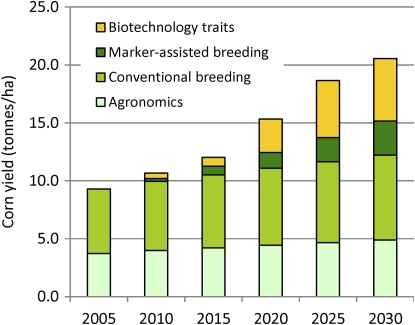Figure 7.
Anticipated impact of improvements in agronomics, breeding, and biotechnology on average corn yields in the United States. Rate of yield improvement due to breeding is extrapolated from observations such as those shown in Figure 3B, using data extending across maturity groups from Monsanto's North American corn breeding program. Agronomic (planting density, fertilizer use efficiency, improvements in soil management) contributions to the rate of yield improvement are considered to proceed at current historical rates based on estimates in Duvick (2005). Rate of yield improvement for biotechnology traits is a combination of the effects of current yield-protecting biotechnology traits, the introduction of biotechnology traits for drought tolerance, and additional yield-enhancing biotechnology traits. Biotechnology contributions to yield from herbicide tolerance, corn borer, and corn rootworm protection are estimated from the data presented in Figure 5. Biotechnology contributions to yield from drought tolerance are estimated from data presented in Figure 6 and an assumption that drought conditions strong enough to reduce yield will be seen on approximately 10% of the planted acres. Biotechnology contributions from yield-enhancing transgenes assume the introduction of three new biotechnology traits with effects similar to those described by Padgette (2008) over the course of the next decade. In each case biotechnology trait adoption curves such as those observed for current commercially available biotechnology traits are assumed (Monsanto, 2008).

